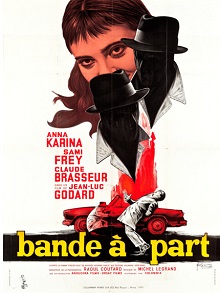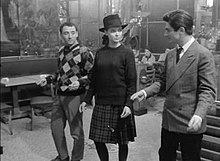Bande à part (film): Difference between revisions
m Dating maintenance tags: {{Deadlink}} |
Rescuing 1 sources and tagging 0 as dead. #IABot (v1.4.2) |
||
| Line 72: | Line 72: | ||
==Critical reception== |
==Critical reception== |
||
''Bande a part'' has a 96% rating on [[Rotten Tomatoes]] based on 47 reviews.<ref>[https://www.rottentomatoes.com/m/band_of_outsiders "Band of Outsiders (Bande à part) (1964)"]. rottentomatoes.com. Retrieved July 17, 2017.</ref> Film critic Pauline Kael described ''Bande à part'' as "a reverie of a gangster movie" and "perhaps Godard's most delicately charming film".<ref>{{cite news |title=Godard Among the Gangsters|work=''[[The New Republic]]''|author=[[Pauline Kael|Kael, Pauline]]|year=September 10, 1966|accessdate=July 17, 2017| url=https://newrepublic.com/article/93946/godard-among-gangsters}}</ref><ref>[http://www.filmforum.org/archivedfilms/bandpress.html BAND OF OUTSIDERS at Film Forum in NYC]{{ |
''Bande a part'' has a 96% rating on [[Rotten Tomatoes]] based on 47 reviews.<ref>[https://www.rottentomatoes.com/m/band_of_outsiders "Band of Outsiders (Bande à part) (1964)"]. rottentomatoes.com. Retrieved July 17, 2017.</ref> Film critic Pauline Kael described ''Bande à part'' as "a reverie of a gangster movie" and "perhaps Godard's most delicately charming film".<ref>{{cite news |title=Godard Among the Gangsters|work=''[[The New Republic]]''|author=[[Pauline Kael|Kael, Pauline]]|year=September 10, 1966|accessdate=July 17, 2017| url=https://newrepublic.com/article/93946/godard-among-gangsters}}</ref><ref>[http://www.filmforum.org/archivedfilms/bandpress.html BAND OF OUTSIDERS at Film Forum in NYC] {{webarchive|url=https://web.archive.org/web/20080719062937/http://www.filmforum.org/archivedfilms/bandpress.html |date=19 July 2008 }}</ref> ''Bande à part'' is often considered one of Godard's most accessible films; Amy Taubin of the ''[[Village Voice]]'' called it "a Godard film for people who don't much care for Godard".<ref>[http://www.villagevoice.com/film/0133,taubin,27251,20.html Taubin, Amy. "Prime Movers," ''Village Voice'', 15 August 2001.]</ref> Its accessibility has endeared the film to a broader audience. For example, it was the only Godard film selected for ''[[Time (magazine)|Time]]''{{-'}}s ''All-TIME 100 movies''.<ref>[http://www.time.com/time/2005/100movies/the_complete_list.html The complete list – ALL-TIME 100 Movies – Time Magazine]</ref> ''Bande à part'' was also ranked No. 79 in ''[[Empire (magazine)|Empire]]'' magazine's "The 100 Best Films of World Cinema" in 2010.<ref>{{cite web | title = The 100 Best Films of World Cinema | 79. Bande à part | url = http://www.empireonline.com/features/100-greatest-world-cinema-films/default.asp?film=79 | work = [[Empire (magazine)|Empire]] }}</ref> |
||
==References== |
==References== |
||
Revision as of 19:41, 17 July 2017
| Bande à part | |
|---|---|
 Bande à part poster | |
| Directed by | Jean-Luc Godard |
| Written by | Jean-Luc Godard (uncredited) |
| Starring | Anna Karina Sami Frey Claude Brasseur |
| Cinematography | Raoul Coutard |
| Edited by | Agnès Guillemot |
| Music by | Michel Legrand |
Production companies | Anouchka Films Orsay Films |
| Distributed by | Columbia Pictures |
Release date |
|
Running time | 97 minutes |
| Country | France |
| Language | French |
| Budget | $120,000 (estimated) |
Bande à part (French pronunciation: [bɑ̃d a paʁ]) is a 1964 French New Wave film directed by Jean-Luc Godard. It was released as Band of Outsiders in North America; its French title derives from the phrase faire bande à part, which means "to do something apart from the group".[1] Godard described it as "Alice in Wonderland meets Franz Kafka".[2] Bande à part is about three people who commit a heist. It received positive critical reviews, and its dance scene has been referenced several times in popular culture. The film is an adaptation of the 1958 novel Fool's Gold by American author Dolores Hitchens.
Plot
Odile (Anna Karina) meets a man named Franz (Sami Frey) in an English language class. She has told him of a large pile of money stashed in the villa where she lives with her aunt, Madame Victoria and a man named Monsieur Stoltz in Joinville, a Parisian suburb. Franz tells his friend Arthur (Claude Brasseur) of the money – and his nascent romance with Odile – and the two hatch a plan to steal it. Meanwhile, Franz and Arthur try to seduce Odile. Ultimately, Arthur wins Odile, and they spend the night together.
Arthur's uncle learns of their plot and wants a cut of the money. Franz, Arthur, and Odile now must commit the robbery the night before they had planned, the night they knew M. Stoltz would be away from home. Moreover, M. Stoltz grows suspicious, and he hides the money and changes the locks. When they arrive, Franz and Arthur tie up Mme. Victoria and lock her in an armoire. They only find a small amount of cash in the house, and when they open the armoire to interrogate Mme. Victoria about the rest of the money, she appears to be dead. Franz, Arthur, and Odile flee the scene at once, until suddenly, Arthur declares he will return to the home, to verify that Mme. Victoria is in fact dead.
This is a ploy: Arthur knows where the rest of the money is hidden, and he plans to take it for himself. But on the highway, Franz notices Arthur's uncle heading in the direction of the villa; he and Odile turn around to follow. There, they witness Arthur being shot by his uncle repeatedly after finding the rest of the money in the doghouse. As he breathes his last, Arthur shoots his uncle in return. Odile rushes toward the body, but Franz pulls her away as M. Stoltz pulls up to the house. M. Stoltz gathers up the pile of money that is on the ground and walks up the stairs of the house. This is also where we learn that Mme. Victoria is alive, as she appears in the doorway and meets M. Stoltz as he enters the house.
Odile and Franz drive off with a small stack of money from the robbery. Odile, crestfallen, declares, "I'm disgusted with life." The two decide to flee to South America, and the narrator declares his story has ended here, "like in a pulp novel", and promises a sequel "in CinemaScope and Technicolor" chronicling Odile and Franz's tropical adventures.[3]
Cast
|
|
Note: Character names are not indicated in on-screen cast credits.
Memorable scenes

- "A minute of silence": Arthur, Franz and Odile are in a crowded café and decide to observe a minute of silence; as they do so, the film's soundtrack is plunged into complete silence. This silence actually lasts only 36 seconds and is interrupted by Franz who says "Enough of that."
- The Madison scene: Shortly after, Odile and Arthur decide to dance. Franz joins them as they perform a dance routine. The music is R&B or soul music composed for the film by Michel Legrand but Anna Karina said the actors called it "the Madison dance," alluding to a novelty dance of the time.[4]
- The Louvre scene: The characters attempt to break the world record for running through the Louvre museum. The narration informs that their time was 9 minutes and 43 seconds which broke the record set by Jimmy Johnson of San Francisco at 9 minutes and 45 seconds.
In popular culture
- In tribute to Godard, Quentin Tarantino named his film production company, A Band Apart.[5]
- The Madison scene influenced the dance scene with Uma Thurman and John Travolta in Tarantino's Pulp Fiction.[6] It also influenced scenes in Hal Hartley's Simple Men[7] and Martin Hynes' The Go-Getter.[8] In Roger Michell's Le Week-End, the principal characters see the dance scene on a television in their Paris hotel room and briefly dance along with it. The final scene of the movie is a longer reenactment in a café after one of the characters plays the music on a jukebox. The entire coffeehouse dance scene was also used as the music video for the song "Dance with Me" by Nouvelle Vague from their 2006 album Bande à Part. The group took their name from a scene in the movie, where Odile and Arthur are walking on a street and pass a business with Nouvelle Vague (New Wave or New Trend) in large letters over the door.
- The Louvre scene is referenced in Bernardo Bertolucci's The Dreamers (2003) in which its characters break the Louvre record.
Critical reception
Bande a part has a 96% rating on Rotten Tomatoes based on 47 reviews.[9] Film critic Pauline Kael described Bande à part as "a reverie of a gangster movie" and "perhaps Godard's most delicately charming film".[10][11] Bande à part is often considered one of Godard's most accessible films; Amy Taubin of the Village Voice called it "a Godard film for people who don't much care for Godard".[12] Its accessibility has endeared the film to a broader audience. For example, it was the only Godard film selected for Time's All-TIME 100 movies.[13] Bande à part was also ranked No. 79 in Empire magazine's "The 100 Best Films of World Cinema" in 2010.[14]
References
- ^ Chang, Justin (5 May 2016). "Review B-movie fantasy meets hard-scrabble reality in Jean-Luc Godard's exquisite 'Band of Outsiders'". Los Angeles Times. Retrieved 17 July 2017.
{{cite news}}: Italic or bold markup not allowed in:|work=(help) - ^ Archer, Eugene. "Film Festival: New Wave at Its Crest," The New York Times, 19 September 1964
- ^ Vishnevetsky, Ignatiy (5 May 2016). "Jean-Luc Godard's perennially cool Band Of Outsiders returns to theaters". A.V. Club. Retrieved 17 July 2017.
{{cite news}}: Italic or bold markup not allowed in:|work=(help) - ^ Karina, Anna. Interview on the Criterion Collection edition of the film.
- ^ Kenneth Turan "Godard's "Band of Outsiders" returns with its charms intact", Baltimore Sun, 17 August 2001.
- ^ Channel 4: British Film Institute: Bande à Part "A-Z Guide"
- ^ Hernandez, Eugene. "Godard's Outsiders Back in 35mm", indieWIRE, 6 June 2001.
- ^ Martin Hynes Talks M. Ward, The Origins of She & Him and the Music of 'The Go-Getter". The Playlist. 28 May 2008.
- ^ "Band of Outsiders (Bande à part) (1964)". rottentomatoes.com. Retrieved July 17, 2017.
- ^ Kael, Pauline (10 September 1966). "Godard Among the Gangsters". The New Republic. Retrieved 17 July 2017.
{{cite news}}: Italic or bold markup not allowed in:|work=(help) - ^ BAND OF OUTSIDERS at Film Forum in NYC Archived 19 July 2008 at the Wayback Machine
- ^ Taubin, Amy. "Prime Movers," Village Voice, 15 August 2001.
- ^ The complete list – ALL-TIME 100 Movies – Time Magazine
- ^ "The 100 Best Films of World Cinema | 79. Bande à part". Empire.
